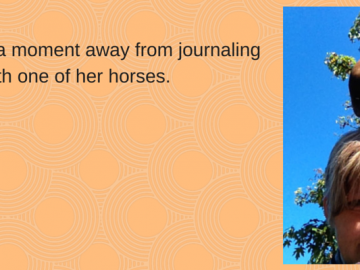
Is focus always a good thing? Middle managers focus on success in their slices of the organization chart. Researchers focus on patterns and themes in their data. In quantitative research, we look for statistically significant patterns and themes.
In our society, we are pushed to narrow and clearly define our boundaries. In research, this is how we end up with studies such as: “Behavioral and environmental correlates of parasite burden in Eulemur cinereiceps from southeastern Madagascar.” A tight focus helps us create new knowledge of certain types.
Borrowing from Horsemanship
There is an expression in horsemanship: hard eyes and soft eyes. Hard eyes give you a tight, confined, left-hemisphere kind of focus. Soft eyes make you more horse-like, and allow you to perceive a broader range of stimuli. Have you seen the selective attention video from Daniel Simons’ research? In it, you count the number of basketball passes by players wearing white. The video is often used with large groups, charged with a sense of competition to get the right answer. This video is a wonderful illustration of what we do every second of every day. We filter out information if it does not fit what we are looking for. Here is a link to the video.
Diversity
I am interested in diversity. (See another post about diversity here.) So I am not always interested in a tight focus. I don’t just mean diversity in the way most human resources professionals use it. For example, I am interested in different ways of seeing situations. When you use a “soft eyes” approach to leadership, you find the interesting outliers and the positive deviants. In June, Fred’s ideas might be most helpful. In July, things have changed and Susan’s approach becomes key.
A Research Method that Seeks Diversity
There is a research method designed to surface diversity. It is called phenomenography. Although it was developed for a specific use in education, many of us have adapted it (more to come about that in a future post).
To give you an idea of how phenomenography works, Scandanavian researchers Larsson, Holmström and Rosenqvist worked with nineteen anaesthetists to see how they understood their work. Through their analysis they found four distinct ways, which they labeled Professional Artist, Good Samaritan, Servant and Co-ordinator. One of those ways–The Servant–was more comprehensive than others. This was useful because it provided guidance for new professional development designs.
Does Focus Make us Separate Parts of our Lives?
Those of us who work with clients and universities sometimes separate academic and practical work. But they aren’t really separate at all. In thinking back to my early work with parks, I realized I did a small phenomenographic study years before I heard the term. I was working as a park interpreter. We presented programs to people who were camping in the park or lived nearby. I knew several skilled and dedicated birdwatchers in the area. So I interviewed them, asking about how they got hooked on birdwatching. Each of the six stories was unique, and all had led to success, respect and often to careers.
For example, one man had grown up as an only child in a remote northern area. He wanted to get close to birds, but no matter how still he sat, perched in a tree, they didn’t come to him. Until he realized grain from the barn could draw some of them in. His story evolved from there. Another man had been with a competitive birder, who announced bird species when they were specks on the horizon. When he realized this person was actually recognizing species accurately from tiny clues, he was hooked; he also became a competitive birder. This informal study showed there are diverse paths to success. We should keep that in mind as leaders, employers, teachers and parents. Had I not been open to very different answers to my question, I might have missed gems that were valuable for the park visitors.
Why the Donkey?
 So why did I include a donkey image in a post about focus? This photograph was taken by Danique Rowsell as part of a professional photo shoot of Lisa Patton’s daughter Sidney, with her horse Mister. Lisa was rounding up their miniature horses to keep them away from the photo shoot. She didn’t even think about Fred the donkey, because he normally followed her everywhere.
So why did I include a donkey image in a post about focus? This photograph was taken by Danique Rowsell as part of a professional photo shoot of Lisa Patton’s daughter Sidney, with her horse Mister. Lisa was rounding up their miniature horses to keep them away from the photo shoot. She didn’t even think about Fred the donkey, because he normally followed her everywhere.
No one noticed that Fred snuck into the photo!




